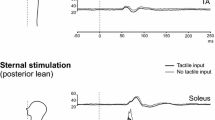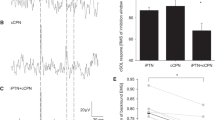Abstract.
The possibility was investigated that changes in heteronymous recurrent inhibition (RI) from quadriceps (Q) to soleus (Sol) and tibialis anterior (TA) motoneurons (MNs) occur during postural tasks requiring co-contraction of Q with one of these muscles. Stimulation of the femoral nerve (FN), which elicited a Q H-reflex discharge, was used to activate Renshaw cells. The resulting inhibition of TA and Sol MNs was assessed using three test responses: (1) the rectified and averaged ongoing electromyogram (EMG) activity in TA or Sol; (2) the motor-evoked potential (MEP) elicited by cortical stimulation in these muscles; and (3) the Sol H reflex. The characteristics of the depression (appearance and increase with the conditioning reflex discharge, short central delay and long duration) are consistent with a Renshaw origin. In addition, results obtained in control experiments (no change in the EMG suppression after an ischaemic blockade of group-I afferents from the leg, time course of the FN-induced depression of the MEP similar to that of the ongoing EMG) made a significant contribution from other pathways activated by FN stimulation unlikely. Posture-related heteronymous RI from Q was compared in different postural tasks at matched levels of background EMG activity: voluntary co-contraction of Q and of the relevant ankle muscle while sitting (control situation), postural co-contraction of Q and TA (while leaning backwards during stance), or contraction of Sol with (preparation for hopping) and without (standing on tip of toes and leaning forwards during stance) associated contraction of the Q. During stance, heteronymous RI from Q was reduced to TA (but not to Sol) while leaning backwards and to Sol in preparation for hopping, but not in the other situations. Thus, RI from Q to TA or Sol was specifically decreased when a co-contraction of the Q and of the relevant muscle operating at the ankle was required to maintain bipedal stance. It is argued that this control of Renshaw cells is descending in origin and contributes to selection of the appropriate synergism in various postural tasks.
Similar content being viewed by others
Author information
Authors and Affiliations
Additional information
Electronic Publication
Rights and permissions
About this article
Cite this article
Barbeau, H., Marchand-Pauvert, V., Meunier, S. et al. Posture-related changes in heteronymous recurrent inhibition from quadriceps to ankle muscles in humans. Exp Brain Res 130, 345–361 (2000). https://doi.org/10.1007/s002219900260
Received:
Accepted:
Published:
Issue Date:
DOI: https://doi.org/10.1007/s002219900260




